FTX Pushes Debt Claim Deadline to Streamline Bankruptcy Plan

Key Insights:
- FTX extends proof of debt submission deadline, aiming to give creditors ample time to file claims during bankruptcy proceedings.
- Former FTX executive Ryan Salame seeks an 18-month sentence, citing significant cooperation with authorities in unraveling the exchange’s financial misdeeds.
- As FTX continues asset auctions, global regulators ramp up efforts to impose stricter cryptocurrency and Web3 regulations to prevent future financial crises.
FTX Digital Markets has announced an extension to the deadline for creditors to submit proof of debt claims. Initially set for May 15, 2024, the new deadline has been pushed back by 10 to 12 weeks. This extension aims to provide creditors sufficient time to participate in the ongoing bankruptcy proceedings. The company, which declared bankruptcy previously, has faced scrutiny and legal challenges, prompting a structured approach to address creditor concerns and ensure orderly debt reconciliation.
The extended period for submitting claims coincides with the creditors’ voting deadline on a Chapter 11 reorganization plan in the United States. This synchronization is intended to streamline the process and reduce confusion among stakeholders. FTX has clarified that customers affected by the bankruptcy can only engage in either the Bahamas or U.S. legal processes, not both. Detailed instructions on how to navigate these options will be provided to customers, allowing them 6 to 8 weeks from the issuance of disclosures to make their choice.
Addressing Payment Complexities
FTX’s approach to resolving claims includes a strategy to distribute assets equitably among creditors, a promise that has been met with mixed reactions within the cryptocurrency community. The exchange has disclosed that it expects to have between $14.5 and $16.3 billion in cash available for distribution by the time the Delaware bankruptcy court approves the reorganization plan. Despite these assurances, delays and the complexity of the bankruptcy process have led to growing frustration among creditors.
Crypto analyst Thomas Braziel has expressed concerns about potential discrepancies between customer balances and the assets listed by FTX at the time of filing for bankruptcy. Braziel referenced the Cryptopia bankruptcy case as a possible model, where assets were treated as separate entities, and losses in one ‘silo’ did not affect the distribution of assets in another. This method could potentially offer a framework for addressing similar complexities in the FTX case.
Legal Developments and Future Outlook
In related news, Ryan Salame, a former top executive at FTX, has sought leniency from the court following his cooperation with federal authorities. Salame, who pleaded guilty to charges related to unlawful political contributions and operating an unlicensed money-transmitting business, has requested a reduced sentence of 18 months in prison, compared to the potential maximum of 10 years. His cooperation was instrumental in providing insights into the internal workings of FTX, separate from the actions led by Sam Bankman-Fried, the exchange’s founder, who has been sentenced to 25 years.
The resolution of these legal matters and the ongoing efforts to refund customers reflect a significant phase in the FTX bankruptcy saga. As the case progresses, the outcomes will likely influence regulatory approaches and operational standards within the global cryptocurrency market.
Regulatory Responses and Market Impact
The fall of FTX has prompted regulatory bodies worldwide to take a more stringent approach towards cryptocurrency exchanges. The European Union, among others, is leading efforts to implement comprehensive Web3 and cryptocurrency regulations to prevent the recurrence of such financial disasters. The regulatory landscape is rapidly evolving, with governments aiming to balance innovation in digital asset markets with robust consumer protections.
Simultaneously, the disposition of FTX’s assets, including auctions of locked cryptocurrency holdings like Solana, managed by entities such as Pantera Capital, is an essential step towards satisfying creditor claims. This process not only impacts the direct stakeholders but also serves as a cautionary tale for other exchanges and financial institutions in the digital asset space.
Editorial credit: Sergei Elagin / Shutterstock.com
DISCLAIMER: It's essential to understand that the content on this page is not meant to serve as, nor should it be construed as, advice in legal, tax, investment, financial, or any other professional context. You should only invest an amount that you are prepared to lose, and it's advisable to consult with an independent financial expert if you're uncertain. For additional details, please review the terms of service, as well as the help and support sections offered by the provider or promoter. While our website strives for precise and impartial journalism, please be aware that market conditions can shift unexpectedly and some (not all) of the posts on this website are paid or sponsored posts.









